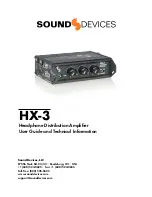
40
Tone control settings – Room Correction
(Tone menu)
Introduction
The
P 3000 HV
is fitted with an
analogue tone processor module
which can
be used to provide wide-ranging corrections to the listening room acoustics, and
fine-tune the tonal balance of sub-optimal recordings or sound media which
have deteriorated with age. The module consists of three function blocks:
Tone controls
User-variable aurally-compensated volume correction
(Loudness)
Triple parametric equalizer
It is possible to by-pass individual function blocks which are not required, and
remove them from the signal path by means of lossless gold-contact relays.
All the function blocks of the processor module are controlled by a micro-
processor, but are constructed entirely using analogue circuit technology. This
means that A/D and D/A conversion processes, which can have an adverse
effect on sound quality, do not take place here.
Tone controls
The tone controls can be employed both to correct the tonal balance of aged
recordings (e.g. old tape recordings, with loss of treble) and to adjust repro-
duction in dull, acoustically over-damped or reverberant rooms.
Loudness
The human auditory system is by no means linear. At low volume the ear’s
sensitivity declines much more markedly at low and high frequencies than in the
mid-frequency range. This means that the listener’s impression of the music
varies greatly according to the volume at which it is played. In strict terms then,
faithful music reproduction is only possible if it is played back at exactly the
same level as was experienced when the recording was made. This is often
impossible or undesirable in the domestic living room. At reduced volume in the
listening room bass and treble sounds are perceived subjectively as quieter,
while the mid-range appears to be emphasised. Reproduction tends to sound
“flat”, with excessive stress on the mid-range.
At low volume, the aurally-compensated volume correction function (Loudness)
adjusts playback to compensate for the decline in hearing sensitivity. For this to
work accurately, Loudness must be adjusted to match the efficiency of your
loudspeakers and the listener’s distance from them. For this reason the
P 3000
HV
’s Loudness function is user-variable. The “Loudness Level” parameter can
be employed to adjust Loudness very accurately to suit your speakers, your
room acoustics and your distance from the speakers.
Parametric equalizer –
room correction
In every listening room reflections and standing waves form resonances which
can cause droning and serious adverse effects on sound quality, especially at
low frequencies below 200 Hertz. The extent to which resonances form in the
listening room varies strongly according to room geometry, the position of the
loudspeakers and the level of damping in the room. In general terms, the lower
the room’s damping, and the closer the speakers are positioned to a corner or a
wall, the more marked are the resonance effects. Resonance effects can be
reduced by varying the loudspeaker positions, or by fitting special absorbers
(bass traps), but in actual living room environments the results are often limited.
The
P 3000 HV
includes a parametric equalizer module which provides an
electronic means of reducing the effects of resonance and droning. The
equalizers compensate for unwanted over-emphasis and under-emphasis in the
frequency response caused by resonance effects (see Fig. “Frequency
response in the room”) by correcting the frequency in the opposite direction
(
“EQ1, EQ2, EQ3”
). The net result is a largely linear frequency response, as
illustrated in Fig. “Corrected frequency response”.
Summary of Contents for P 3000 HV
Page 2: ...2 ...
Page 22: ...22 ...
Page 50: ...50 ...
Page 61: ...61 Anschluss Schema Wiring diagram H Link ...
Page 64: ... elektroakustik GmbH Co KG Herford Deutschland Germany ...
















































